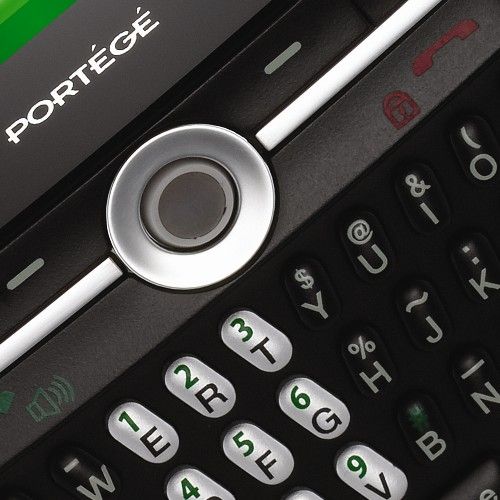They do say that imitation is the highest form of flattery, and at first glance, the G710 is distinctly BlackBerry-esque, with a full QWERTY keyboard below a central "Pearl". The body has that rubberised feel to it, so feels fairly good in the hand. That said, it is fairly large at 62 x 115 x 13mm.
Our quick take
The G710, sitting alongside other competitors in the smartphone arena, just simply doesn’t compete. It just feels like a tool.
For business users who want or need Windows Mobile, there are stronger offerings from HTC and HP for example, but you will pay more. Unfortunately it is a world apart from the BlackBerry design that it apes.
The exterior almost fools you, but once you get to use the G710, it is a disappointment.

Toshiba Portégé G710 mobile phone - 2.5 / 5
| FOR | AGAINST |
|---|---|
|
|
The keyboard, however, feels a little cheap to use but is fairly responsive and if you need to bash out a few emails it is certainly no problem. That is, until you start trying to get to the alternative key characters. Many phones will allow you to press and hold a key to get an alternative character – a number or upper case – but the G710 just gives you more of the same. Press and hold "X" and rather than "7", you get "XXXXXXXXXXXXXX". Great for kisses to your mistress but little else.
Surrounding the trackball you’ll find the normal call buttons, plus the controls you need to interact with Windows Mobile 6 which drives the device. The Home button is a useful escape from the menu maze, but overall the buttons again feel cheap. The buttons are fairly slow to respond suggesting that the 260MHz Texas Instuments processor lacks the power for the job.
The screen is a 2.46in QVGA that doesn't really excite and struggles to fit anything on thanks to the blocky icons displayed across the top of the screen - until removed by changing the display to "Windows Basic".
As mentioned, the G710 runs Windows Mobile 6, so supports all the normal functions you’d expect, although this is not a touch device, so relies heavily on the tedious menus. Compared to regular mobile phone menus the basic interface is some way behind the game and lacking the touchscreen navigation that almost makes Windows Mobile functional gets the Portege off to something of a poor start.
On the plus side, you do get all the support for your Office applications, but you can’t create anything. You can read them and edit them, yes, but you can’t create a new Word file, which seems a little pointless. Of course, you do get all the contact synchronisation with Outlook via ActiveSync and so on, as well as push email.
Setting up email is fairly simple, although we had problems with the Windows Mobile standard wizard and it is worth the time checking all the settings to ensure that things are correct.
In terms of tech spec, considering this is badged as a smartphone and pitched to the business user, you’ll only find GSM and EDGE support, so no good for fast data on the move. There is an in-built GPS to its credit, but no software to use the GPS, which is frustrating, so you won't be able to use it out of the box.
You do get Bluetooth and the usual Windows Media so you could use this for your music, but really, you don’t want to because the controls are terrible compared to many other phones on the market and your headset plugs in under a cover, which then flaps around as these things do. The supplied headset is of the Mini-USB variety, the sole socket handling all the connections as well as charging.
Battery life is fairly weak, with the tech specs detailing a 4 hour talk time and 8 day standby time. We found that the handset needed charging on a regualr basis, with only fairly basic usage. Certainly this is not the best battery performance and if you are an intensive phone user this could be a problem.
Other features include a 2-megapixal camera and a microSD expansion slot which, despite the device’s size, is hidden under the back cover out of practical reach.
Lack of touchscreen and other features can perhaps be explained away by the value price point of the G710, which you can pick up for little over £200. Whilst this is cheaper than many QWERTY rivals, you have to consider whether it will meet your specific business needs.
To recap
The exterior almost fools you, but once you get to use the G710, it is a disappointment. One for business users only
